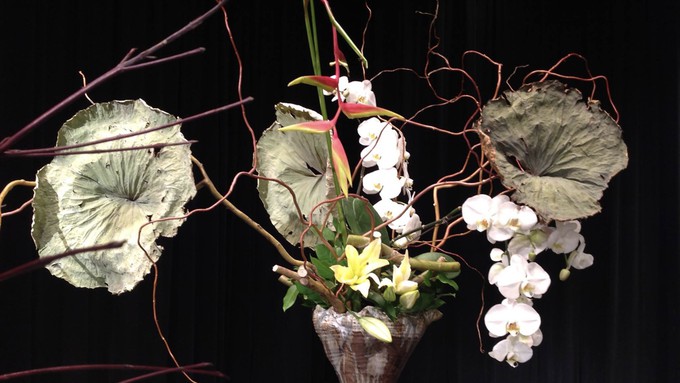
Sacramento show highlights floral freedom of expression

This flower arrangements is an example of Sogetsu Ikebana floower arranging. Many unique creations will be on display this weekend. Photo courtesy Ikebana Arts by Kiki Shibata
“Sogetsu” means “to see well.” In the art of Japanese flower arranging, Sogetsu is a school of Ikebana instruction that’s nearly a century old. Considered “avant-garde” Ikebana, it stresses freedom of expression and pushes the boundaries of what flower arranging can be.
Show hours are 10 a.m. to 4 p.m. Saturday and Sunday. Admission and parking are free.
Shibata and her students will present demonstrations at 11 a.m. and 1 p.m. each day. Learn how they expertly “manipulate” flowers, foliage and other natural materials to create floral arrangements that flow with energy and harmony.
A teacher of Sogetsu Ikebana for nearly 60 years, Shibata offers classes in Sogetsu Ikebana in the Sacramento area. The group meets at Shepard Center on the morning of the second Thursday of each month (except July and August). Classes start at 9:45 a.m.; beginners are welcome. For more information about Sogetsu Ikebana, classes or the show, please call 530-867-0507.
Shepard Center is located at 3330 McKinley Blvd., Sacramento.
Details and directions: www.sgaac.org.
Comments
0 comments have been posted.Sacramento Digs Gardening to your inbox.
Sites We Like
Garden Checklist for week of July 21
Your garden needs you!
* Keep your vegetable garden watered, mulched and weeded. Water before 8 a.m. to reduce the chance of fungal infection and to conserve moisture.
* Feed vegetable plants bone meal, rock phosphate or other fertilizers high in phosphate to stimulate more blooms and fruiting. (But wait until daily high temperatures drop out of the 100s.)
* Don’t let tomatoes wilt or dry out completely. Give tomatoes a deep watering two to three times a week.
* Harvest vegetables promptly to encourage plants to produce more. Squash especially tends to grow rapidly in hot weather. Keep an eye on zucchini.
* Pinch back chrysanthemums for bushy plants and more flowers in September.
* Remove spent flowers from roses, daylilies and other bloomers as they finish flowering.
* Pinch off blooms from basil so the plant will grow more leaves.
* Cut back lavender after flowering to promote a second bloom.
* It's not too late to add a splash of color. Plant petunias, snapdragons, zinnias and marigolds.
* From seed, plant corn, pumpkins, radishes, winter squash and sunflowers.